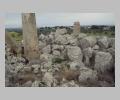| Context: | Selinus |
| Type: | Temple |
| Summary: | One of the largest temples of antiquity, Temple G was left unfinished at the time of the city's destruction in 409 B.C. |
| Date: | ca. 500 BC |
| Dimensions: | 110.36 x 50.1 |
| Period: | Archaic |
Architectural Order:
Doric
Plan:
This temple was hypaethral since the central nave was left unroofed. The vast cella, preceded by a pronaos of four columns, had three doors corresponding to the three inner naves formed by two rows of ten monolithic columns in two tiers.
History:
The variations in style and the fact that many columns are unfluted indicate that the temple was under construction for a long period of time and was not complete at the time of the city's destruction in 409 B.C.
Other Notes:
The columns are over 16 m high with a base diameter of 3.4 m and they weigh approximately 100 tons each. One column remains standing and the fallen capitals at the site give an impression of the colossal scale of the unfinished building.
The size and scope of the temple, as well as the length of time devoted to its construction, lend it many peculiarities and variations of style not found in other Doric temples. Its columnar arrangement (8 x 17) is matched only by the Parthenon.
This temple was probably dedicated to Apollo or Zeus.
Sources Used:
Other Bibliography:





